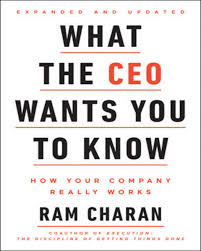Ram Charan is a true thought-leader in business and has been advising CEOs and boards of directors at companies around the world for decades. Subtitled “How Your Company Really Works,” this book is one of this prolific author’s earliest books, yet it remains very relevant today. It is part “textbook,” explaining business fundamentals and the basics of business finance, and part advisory, addressing how to put sound business and leadership practices to work. To be consistent with this bifurcation, I have segmented this summary in accordance with the book’s sections.
Section I – Business Acumen: The Universal Language of Business
Charan feels that the best CEOs are like the best teacher you ever had and that they “are able to take the complexity and mystery out of business by focusing on the core fundamentals.” The most successful business leaders focus on the fundamentals and they have a keen sense of how a business makes money.
Everything in business emanates from cash generation, margin, return on assets, growth, and customers; and true business acumen requires understanding these building blocks of money making. Charan proceeds to address these concepts and others (such as inventory turns, investment capital, fixed and tangible assets, profit margin and cost of capital), providing a nice overview of these business fundamentals utilizing real-world examples.
Section II – Business Acumen in the Real World
Once business leaders understand the aforementioned fundamentals, they must be able to apply them in the real world. Charan writes that “the world has complexity but leaders provide clarity.” This business acumen helps a CEO choose the three or four business priorities that will retain customers and achieve all the important money-making goals. A business priority defines the most important action that needs to be taken at a certain point in time, as well the appropriate response to the unexpected…whether a crisis or an opportunity. Charan stresses that many business leaders falter because they become overwhelmed or indecisive. Some do not set clear priorities or they lose focus, especially if their judgments come into question. If the leader fails to set priorities, keeps changing her mind, or poorly communicates those priorities, the whole organization loses energy. If, on the other hand, she sets business priorities and communicates them clearly and often, people will have a better sense of what to do. If she chooses the “right” set of business priorities, the business will flourish.
Section III – Getting Things Done
Charan writes that CEOs know that, in business, there are quarterly milestones but there are no finishing lines. Leaders have to deliver results day in, day out, relentlessly and consistently over a long period of time. Delivering results is what gives an organization energy, builds confidence, and generates the resources to go forward. So once the CEO has determined three or four business priorities, how will they actually get the work done? Charan suggests that a good leader will harness the efforts of other people, expand their personal capacity, and synchronize their efforts to get results. Leaders who consistently deliver results recognize what people do best (their skills, attitudes, and aptitudes), link the business needs to people’s natural talents, and take the time and effort to place individuals where their strengths can have the most impact. CEOs much have the insight into people and the organization to get the energy aligned.
Charan knows that business excellence alone is not sufficient. A CEO must think first like a businessperson, with a perspective that expands beyond a functional or departmental view to a total business view. So, as CEO, how deep is your understanding of business fundamentals and how well do you apply them? How well do you prioritize business objectives so resources and talents are best utilized? What’s complex at your company? And how can you, as CEO, help provide clarity and focus in cutting through the complexity to achieve key business objectives? These are just a few of the questions that Charan challenges CEOs to ask themselves.

